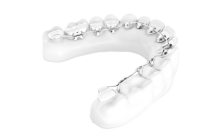Therapy in children and adolescents
When is the ideal start of treatment?
Ideally, the first visit to the orthodontist should be around the age of 9. In general, it must be distinguished whether there is a jaw malposition (position of the upper jaw) or malocclusion (misalignment of the teeth in the individual jaw) or a combination of both.
If caught early, it is possible, if necessary, to influence the growth of the facial skull and the change of teeth to optimize the therapy treatment. In the case of pure malocclusions, the start of treatment can be postponed to a later period if almost all permanent teeth have broken through.
What is an early treatment?
In severe cases of anomalies with a tendency of deterioration and the risk of growth impairment, it is sometimes necessary to perform a so-called early treatment. The aim of the early treatment is to stop the progress of the unfavorable development by a limited time of approx. 1-2 years, to promote the proper dentition development, to positively influence the expected growth and to improve the initial situation for the further change of teeth. Oftentimes, we shorten, simplify or even avoid a later orthodontic treatment through the early treatment.
Elimination of malfunctions, so-called habits
"Habits" can be harmful when they lead to tooth and jaw malpositions. Examples include thumb or finger sucking, lip and tongue biting, incorrect insertion of the tongue when swallowing and many more. Habits are often already present in the deciduous dentition and may interfere with successful orthodontic treatment or prevent a stable result when transferred to the mixed dentition. Quitting these habits is often only possible in close cooperation with speech therapists and occupational therapists. Since the cause of tooth and jaw malformations may in some cases also be related to respiratory and respiratory disorders, cooperation with ENT specialists is often required.
Removable treatment devices
Removable braces
Removable appliances are made of plastic and are provided with passive elements that secure the grip in the mouth. Machined, active elements, such as small screws or springs are used to perform tooth movement in the individual jaw. The removable braces are worn in the individual jaw or in both jaws at the same time and are usually used during the tooth change. Their job is, among other things, to make room for erupting, permanent teeth or to regain space for the permanent teeth when milk teeth have been lost too early.
Functional orthodontic appliances
The functional orthodontic devices lying loosely in the mouth, in contrast to braces in the individual jaw, simultaneously influence the upper and lower jaws and are thus preferably used for the therapy of malposition of the jaws to one another. This type of braces works without exerting force. The orthodontic braces are designed to functionally stimulate the soft and hard tissues of the masticatory system so that muscular functional patterns change and the patients’ jaws react with growth and adaptation in the desired direction.
Invisalign - invisible braces for teenagers
The Invisalign therapy uses thin, transparent plastic bars, so-called aligners, which move the teeth biologically and gently into the desired position step by step. With a specially developed software, the treatment goal is visualized on a virtual model before starting therapy.
What are the benefits for me?
The Invisalign aligners make it possible to adapt the orthodontic treatment to individual life situations, as they can be taken out, for example, during sports or on special occasions. Another advantage is that you do not have these braces in your mouth while eating.
Orthodontic appointments are only required at longer intervals. Depending on the extent of the treatment, the number of custom-made pairs of rails varies, which are exchanged by the patient for the following pair of rails at approximately two-week intervals.
Treatment with teenagers
Prerequisite for therapy with Invisalign is that all permanent teeth are erupted. For teens, the manufacturer has developed a brace system system specifically designed to the needs of young people, the Invisalign-Teen ® Series. In this case, the optimal wearing time is indicated by a small blue color indicator built into the rail. There are also 6 free replacement aligners available should the Invisalign rail ever be lost.
Fixed appliances – Braces on the outside of the teeth
Some tooth movements are possible only with fixed braces, with which the entire tooth can be moved together with its root into the correct position. With the fixed braces on the outside of the teeth, or so-called brackets, small metal or tooth-colored ceramic holding elements are glued to the outside of the teeth. These brackets serve as holding elements for orthodontic treatment sheets, with which the actual tooth movement is performed. A bow change takes place when a certain intermediate goal is reached. In our practice we offer different systems of fixed braces. In a detailed consultation with you we find the ideal choice for your own equipment or that of your child.
Braces on the inside of the teeth - Lingual braces
This form of fixed braces is particularly suitable for patients who want an invisible tooth correction. Since the braces are not visible from the outside, the treatment for outsiders runs completely unnoticed. The principle of a fixed brace on the inside of the teeth works in a similar way to that of fixed braces on the outside of the teeth. Brackets individually made for each patient are attached to the inside of each individual tooth and custom metal arches provide the desired tooth movement. Your desired final result will be demonstrated using a simulation model. With the lingual braces all kinds of misalignments can be treated at any age as soon as all permanent teeth have broken through.
Mini implants / minipins
When do mini implants come in?
The necessary forces for tooth movement lead according to Newton's law "Actio = Reactio", i.e. "force = counterforce", not only to the movement of the desired teeth, but also to change the position of other teeth, if they are not sufficiently stabilized.
Advantages of mini implants
Orthodontic mini-implants are small screws designed to use the jawbone and not the other teeth as an anchor. Since unwanted side effects are prevented, the treatment process is more targeted and can be done faster. Tooth movements, which were limited by previous methods, can be performed, so that often tooth extractions in cases with massive space shortage can be avoided and existing tooth gaps can be closed faster.
Only a small intervention is required
Minipins are mainly used in adolescents and adults. The insertion of the pins is a minimally invasive procedure, which we carry out ourselves in our practice. Under local anesthesia, the screws are inserted only a few millimeters deep into the bone.
_____________________________________________________________________________________________________________________________
Combined orthodontic-oral surgery
Tooth movement in the upper and lower jaw can take place into old age. To correct misalignments of the jaws, growth is needed to control the patient's jaw in the desired direction. If this growth potential no longer exists, an additional surgical correction is required for particularly serious malpositions of the jaw.
The task of the orthodontist in these cases is to form the dental arches prior to surgery so that they can be optimally positioned intraoperatively by the maxillofacial surgeons. This operation will take place in patient settings in dedicated centers.
By managing the consultation hours for combined orthodontic-orthodontic cases in two university clinics, we are able to provide you with expert guidance throughout your therapy.




